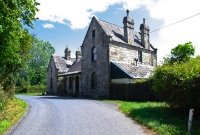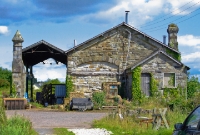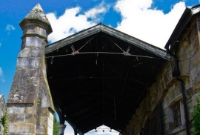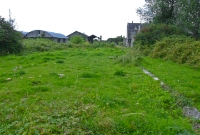Lismore
Lismore, Co.Waterford, was first served by rail when the independent Fermoy & Lismore Railway connected the town with that of the already existing Great Southern & Western's built line from Mallow to Fermoy in September 1872. The F&LR was later taken over by the GSWR in the 1880s. The station at Lismore is probably one of the most architecturally ornate to have been built in Ireland, the design having been greatly influenced by the Duke of Devonshire who resided at the nearby famous Lismore Castle. The two storey stone built station building was located on a single platform, to which at its western end was covered by an overall roof spanning both the through line, loop and goods siding across to the equally ornate goods shed. At the western end of the platform was the wooden GSWR signal cabin, and behind this was the F&LR engine shed and turntable, which had fallen into disused by the 1950s. The overall roof was removed by the Great Southern Railway in 1930s, but the section attached to the goods shed was retained.
Lismore Station was also the terminus of the separate Waterford, Dungarvan & Lismore Railway, who had opened their line between Lismore and Waterford in 1878, eventually forming the Mallow to Waterford line. The WD&LR had their own single platform station east of the larger F&LR one, though it was used for only 10 years. The scenic Mallow to Waterford line was closed in 1967, however the ornate F&LR station still survives in a remarkably well preserved condition, having been a heritage centre for some years. The goods shed is also equally intact. The engine shed has been demolished however, and the GSWR signal cabin is long gone. No trace of the WD&LR station remains, except for the adjacent station masters house.
Lismore Station was also the terminus of the separate Waterford, Dungarvan & Lismore Railway, who had opened their line between Lismore and Waterford in 1878, eventually forming the Mallow to Waterford line. The WD&LR had their own single platform station east of the larger F&LR one, though it was used for only 10 years. The scenic Mallow to Waterford line was closed in 1967, however the ornate F&LR station still survives in a remarkably well preserved condition, having been a heritage centre for some years. The goods shed is also equally intact. The engine shed has been demolished however, and the GSWR signal cabin is long gone. No trace of the WD&LR station remains, except for the adjacent station masters house.




















